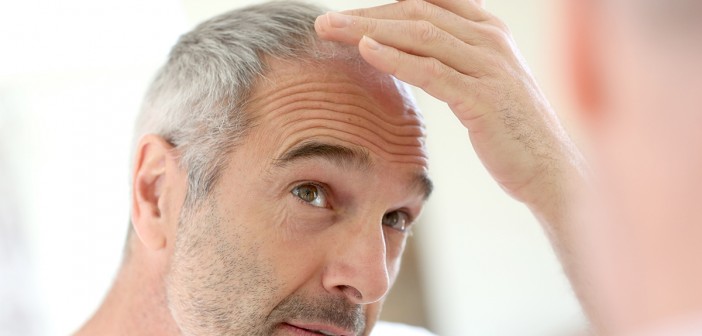It’s the stuff some nightmares are made of. For some, it’s being trapped in a snake den. For others, it’s standing in public in nothing but your underwear. But one fear most older adults all share is the fear of losing our hair. In a society that relishes its long locks, anyone touting a “magical cure” can name his price.
One inevitable fact of life is that thinning hair is a common byproduct of aging. Studies show that up to 50 percent of women over the age will experience hair loss. Sadly, many of us have a genetic predisposition to hair loss, called androgenetic alopecia.
“As we age, overall density changes and individual strands become finer,” explained dermatologist Doris J. Day in her article for Prevention.com.
Before you silently accept your follicle-deprived fate, here are some methods that have shown to reduce the rate of hair loss.
1. You are what you eat.
Your hair is a direct reflection of your diet, so if you don’t like what’s happening on your head, you should pay attention to what’s going in your mouth. Good nutrition has a variety of benefits for your health, but your hair stands to benefit from a diet loaded with protein, zinc, iron, and vitamin B12.
“We know that a nutritious diet is key to healthy skin, functioning organs, an alert mind, and good strong hair. Our kitchen staff really go the extra mile in making sure the food is not only delicious, here at arroyo, but that it is just what our residents need,” said Pamela Fernandez, LPN at Arroyo Vista Nursing Center.
At any age, good nutrition is clearly evident in the condition of our hair. “A strand of hair is composed of mostly protein, which means your hair needs protein to grow,” wrote WebMD contributor, Joseph Saling. “At any given time, about 90% of your hair is in the growing phase. For each individual hair, this growing phase lasts 2 to 3 years. At the end of that time, hairs enter a resting phase that lasts about three months before they are shed and replaced by new hair. If you don’t get enough protein in your diet, a disproportionate number of hairs may go into the resting phase.”
2. Get a massage.
Many people have found success in performing a daily scalp massage. According to Livestrong.com contributor, Shemiah Williams, a three-minute scalp massage not only stimulates the scalp and improves circulation it reduces stress. However, there is no medical evidence fully supporting massaging the scalp as a proven method for preventing hair loss.
3. The heat is on.
Ironically, sometimes our efforts to improve our hair’s appearance is the very thing contributing to its departure. Heated styling products are one of the biggest culprits to increased hair loss.
“Certain hair appliances that use high heat to help style your hair can lead to damaged hair and breakage, which can look like baldness,” wrote contributor Krisha McCoy. “Damaging hair appliances include blow dryers, flat irons, curling irons, and other devices that apply heat to your hair.”
Krisha added that these hot hair appliances cause the most damage to your hair when you use them on wet hair. Some devices get so hot they boil the water in your hair shaft, which leaves your hair brittle.
4. Avoiding certain medications.
If you need added incentive to improve your health to the point of decreasing your medications, hair loss could be a strong motivator. Many prescription medications contribute to increased hair loss in men and women.
“Among the medications that can potentially cause hair loss are blood thinners, vitamin A supplements, some arthritis medications, antidepressants, gout medications, medications for certain heart problems, blood pressure medications, and birth control pills,” wrote Krisha. The good news is that your doctor may be able to prescribe an alternative medication.
According to an ABC News report, men will spend over $1 billion on hair treatment products this year. Men also will spend some $60 million on vitamins and nutritional supplements with dreams of keeping their hair on their head instead of their brush. With new products hitting the store shelves on a seemingly weekly basis, it’s important to research the effectiveness of these methods to determine which ones look promising or should get the brush off.
This article was originally published on Orange County Register. It has been republished here with permission.





